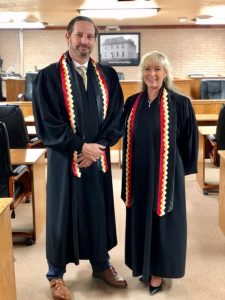Oklahoma Bar Journal
The Back Page | The Greatest Time to Practice Law in Indian Country
By Robert Don Gifford

Tribal Judges Robert Don Gifford (Cherokee) and Lisa Otipoby (Comanche). Photo by Nicole Miskovsky Gifford.
Oklahoma and its 39 tribal nations have been on the cutting edge of Native American law, including the biggest “Indian Country” case, McGirt v. Oklahoma. The recent reemergence of Indigenous law has also mirrored the reawakening of Native American influence on pop culture. From the 1950s through the mid-1980s, the general public’s perception of the “American Indian” was limited to Tonto, dressing up like Pilgrims and “Indians” during elementary school Thanksgiving celebrations and television concluding nightly with an anti-littering campaign and a slow tear rolling down the face of “Iron Eyes Cody” (who was not actually Native but of Italian descent). The late 1980s and ‘90s made the average American feel more culturally aware after going to the movie theater to watch Val Kilmer in Thunderheart, Daniel Day-Lewis in The Last of the Mohicans and, of course, Kevin Costner’s Dances with Wolves. Today, Oklahoma’s tribal nations have once again prominently taken center stage with the best-selling book and the star-studded movie Killers of the Flower Moon and Hulu’s Reservation Dogs.
Outside of pop culture, Oklahoma’s tribes steadily forged their way forward in both commerce and the law. Tribal gaming evolved out of bingo halls and exploded into modern casinos and resorts. Tribal governments became more visible as their business ventures grew beyond the “smoke shops” and bingo halls to modern casinos and resorts, banking, defense contracting and even filmmaking. Even bigger are the tribes’ contributions to funding public schools, building roads, making both water and broadband internet accessible and offering vaccines to Native and non-Native alike during the pandemic.
While this public perception has evolved, lawyers have been quietly fighting battles for decades in the Supreme Court with tribal sovereignty being recognized. From the 1903 Kiowa case of Lone Wolf v. Hitchcock (criminal jurisdiction), the Citizen Band Potawatomi and Sac and Fox cases with victories over the Oklahoma Tax Commission and the 2005 tribal victory in Cherokee Nation v.
Leavitt in demanding Congress fulfill its health care obligations. The biggest came in 2020 when Oklahoma was told by the U.S. Supreme Court that more than half of its counties were on a reservation in the poetic McGirt decision (and its progeny). The state also received its own Supreme Court victory with newfound Indian Country prosecutorial powers in the controversial Castro-Huerta.
Whether in tribal, state or federal court, there has never been a better time than right now to be a lawyer who works with the tribes and tribal members. What many Oklahoma lawyers may not realize, however, is that McGirt has now expanded into their own legal practices as well. Regardless of the area of practice, every lawyer’s professional obligation to stay competent must now include an analysis of the implication of the McGirt v. Oklahoma decision.
Mr. Gifford practices in Oklahoma City. A tribal member of the Cherokee Nation, he is also a tribal court judge for the Seminole Nation, Iowa (Ioway) Tribe of Oklahoma, Kaw (Kanza) Nation, Absentee-Shawnee Tribe and Miami Tribe of Oklahoma, as well as a Comanche Nation Supreme Court justice.
Originally published in the Oklahoma Bar Journal – OBJ 95 No. 4 (April 2024)
Statements or opinions expressed in the Oklahoma Bar Journal are those of the authors and do not necessarily reflect those of the Oklahoma Bar Association, its officers, Board of Governors, Board of Editors or staff.
